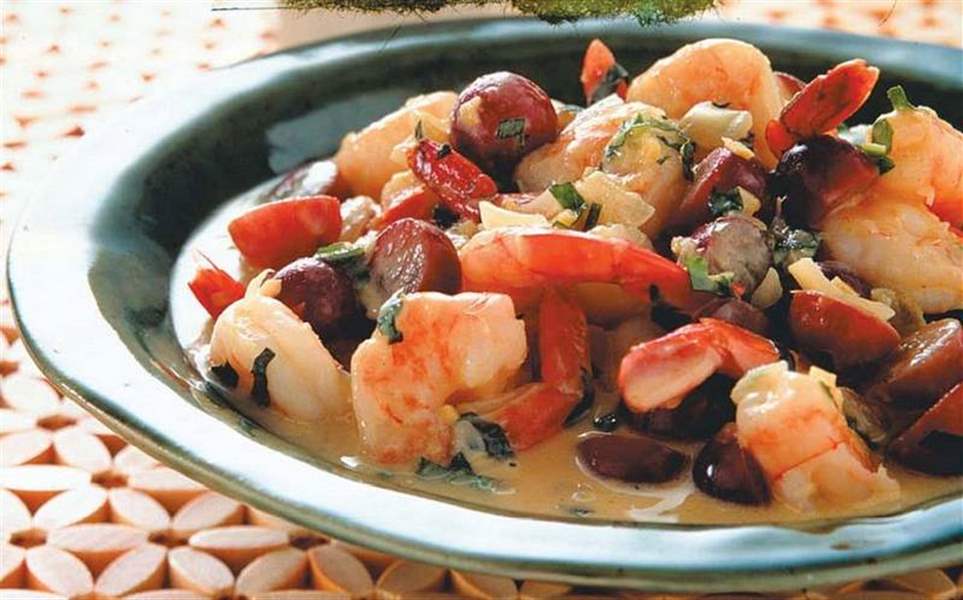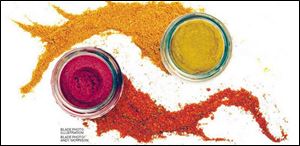
Dishing up curry: Local, authentic Indian and Thai dishes inspire area cooks
4/1/2008
Thai Shrimp Curry with Grapes and Fresh Basil.

A jar of green curry paste, above right, with a tail of curry spice, and a jar of red curry paste with a tail of red curry spice.
You don t have to leave Toledo to discover the world of curry. Thanks to local ethnic shops and restaurants, you can taste and compare a variety of curries from Indian to Thai dishes. Or you could experiment with your own versions at home.
Because of a growing interest in these foods, more and more cookbooks are on the market that are eager to show home cooks how to streamline ethnic recipes and adapt them to the American plate.
The key is to start with the basic spices and ingredients.
Curry spice is well known to most home cooks. It is a blend of many spices as unique as the person blending them. Commercial curry powder has cayenne, coriander, cumin, fennel seeds, fenugreek, black pepper, and turmeric, which gives curry its distinct yellow color. Heat levels range from mild to spicy. Hotter blends are labeled Madras.
Indian cooks such as Revathi Chillapalla don t buy the blends. She makes her own mixture for the 12 to 18 dishes in the deli case of Deepam India, which she owns with her husband, Siva.

Thai Shrimp Curry with Grapes and Fresh Basil.
Authentic cooks choose their preferred individual spices and toast, grind, and combine them in amounts suitable to a specific dish.
Curry leaves are a component of some curry powders. With small, shiny green leaves from the curry plant, they have a citrus scent similar to lemongrass and a pungent bitterweet flavor. It s a product sold at Deepam at 7406 West Central Ave.
Curry paste is available in East Indian and Asian markets as well as the international foods aisle of supermarkets. It is a blend of ghee (clarified butter), curry powder, vinegar, and other seasonings, according to the Food Lover s Companion. It s used in place of curry powder for some curried dishes. Turmeric is a common ingredient in curry recipes.
I play a lot with curry recipes I make with sauces, says Mrs. Chillapallai about the combinations of spices. But in general, she uses canola oil or olive oil for the oil and yogurt in place of cream. We make our own ginger garlic paste for all nonvegetarian dishes and some vegetarian dishes.
Indian curry can mean anything with (a sauce) or gravy, says Mrs. Chillapalli, pointing to the cold food case of the deli and food market.
The day I visited she had cashew chicken curry, lamb curry, vegetable curry made with cauliflower, potato, tomato, and spices, and Spicy Andhra Chicken Curry made with a regional blend of spices.
Balti Chicken made with boneless chicken pieces is cooked with cherry tomatoes, sweet, sour, and spicy sauce and contains coconut. Coconut is an ingredient more often used in Thai curries, according to Mrs. Chillapalli. Garlic ginger paste is used in many dishes
Most Indian curry dishes call for long, slow cooking. Saute and cook on a slow fire, she says. Our lamb cooks 4 hours. Our chicken 2 hours.
For cooks who are intimidated by the long list of ingredients, steps, and techniques in Indian cooking, several new cookbooks seek to prepare dishes in less time. Madhur Jaffrey shares her secrets for curries, chutneys, and one pot Indian meals in Madheur Jaffrey s Quick and Easy Indian Cooking (Chronicle, $19.95). Recipes include Scallops in Spinach-Tomato Curry Sauce and Mushroom Curry.
Serve curry with Indian breads such as naan (thick flat bread) or roti (thin flat bread). Both are sold at Deepam.
Thai curry is hotter than Indian curry. There s no yellow color, says Darla Pollex, owner with her husband Richard of Darla s Thai Pan at 4011 Secor Rd. Unit C.
We have our own herbs and spices and mix that with lemon grass, lime leaves, a galanga (a root vegetable), says the native of Thailand who married her husband 38 years ago when he was in the U.S. Air Force. The couple have three grown children and six grandchildren.
Thai curries are also cooked more quickly than many Indian curries. The curry spice and herbs are mixed with coconut milk and stirred for 5 minutes in a wok until it is mixed well, she estimates. Then the meat and vegetables are added and cooked 5 to 10 minutes until it smells good.
Using authentic Thai recipes, Thai Pan features Gang Thai Traditional Curry Dish made with vegetables or tofu, chicken or pork, beef, shrimp, or seafood (shrimp, scallop or calamari).
The Gang Dang Red Curry has a choice of meat with coconut milk, bell peppers, bamboo shoots, lime leaf, and sweet basil.
Gang Keaw Warn Green Curry is milder, according to Mrs. Pollex. It is made with coconut milk, zucchini, eggplant, lime leaf, and sweet basil.
A special blend red curry is Gang Panang, a spicy curry made with red peppers, bell peppers, lime leaf, and sweet basil and coconut milk. There is also a red curry with no coconut milk.
Gang Masaman Yellow Curry is made with choice of chicken or pork slow cooked in Masaman curry and coconut milk with chunks of potatoes, onion, and ginger. It is similar to Indian, says Mrs. Pollex.
Thai curry often uses red curry paste or green curry paste. Purchase curry paste in the supermarket, often in the ethnic foods aisle. Both pastes can be made at home.
Gourmet Thai in Minutes by Vatcharin Bhumichitr (Kyle, $19.99) has recipes for both pastes using long dried red chilies for the red curry paste and long fresh green chilies and small fresh green chilies for the green curry paste. Also from the cookbook is Chicken Curry with Bamboo Shoots.
Thai Shrimp Curry with Grapes and Fresh Basil is made with green curry paste and fish sauces, coconut milk and fresh ginger.
Kathie Smith is The Blade s food editor. Contact her at food@theblade.com or 419-724-6155.